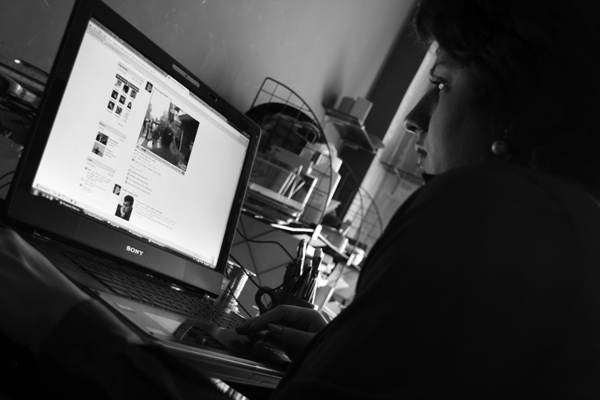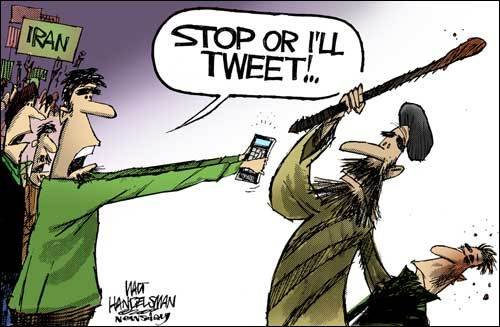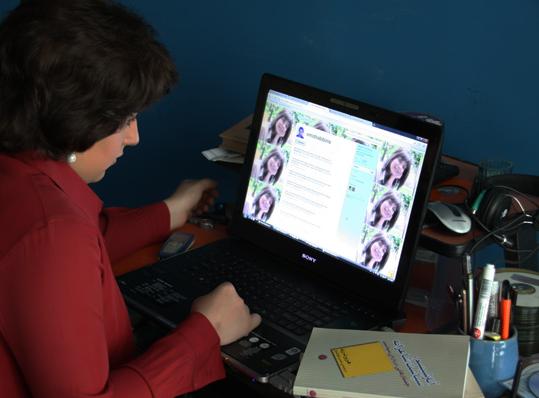 I
In the last five years, social networking has not only introduced a new use of the internet, but has also changed our life style.
The first social networks were only used as means of amusement and pleasure, but today, the political and social lives of many users have been influenced by them as well.
The three web sites of Facebook , good for exchange of information, groups, and friend finding, Youtube, best for sharing videos, and Twitter, capable of spreading news very fast, were most useful for those professional users of internet.
The use of these three web sites in the American presidential elections, which became known as “net campaigns”, made clear just how effective these sites are for attracting the public.
Most social networking sites, with the exception of sites like “Club”, have always been filtered in Iran. But it seems this was less due to religious and ethical worries than to the fear that those sites might be used as a new kind of media.
When Facebook, a symbol of a new generation of social networking, became famous amongst Iranians, it was quickly filtered in Iran, and it was filtered up to last February. Then, surprisingly, both Facebook and Youtube became accessible again!
Conspiracy delusion or intelligence machinations?When Facebook was finally available in Iran, hundreds of thousands of users registered in the first month. This sudden and unexpected passion for Facebook caught the attention of the web site’s management as well. Some reports say that after four and a half months that Facebook was accessible in Iran, the number of registered Iranians increased by 7000% !! And statistics say that today more than six hundred thousand people within Iran are a member of this site.
Even though Facebook never publishes membership numbers according to country, two indicators show that during the spring of 2009, this site became the most popular among Iranians. One is the report of international interactions in Facebook, which compared to the previous year’s season shows incredible increase of Facebook users in Iran. This compelled the Facebook management to make Facebook available in Persian, and by the beginning of the protests in June, Persian Facebook was already up and running.
The second indicator was statistics from sites such as Aleksa, which showed unprecedented increase in the population of Iranian users. And in the last few days before the elections, Facebook was the third popular site in Iran, after Yahoo and Google.
But what made those in charge of censorship on Iran, used to filtering every blog containing even the slightest anti-regime content, decide to make Facebook and Youtube available?
There were signs showing that the regime’s intelligence agents were monitoring and tracing opposition forces and journalists, and at the time some believed that Facebook was a great way to control secret and open movements. Others thought the government wanted to use Facebook and Youtube for election campaigning, as it had been used in USA, providing them with a reference base of 25 million users. However not only did we not see official Islamic Republic agents using Facebook and Youtube for advertising, but there also isn't a single fan page for Ahmadinejad in Facebook - where you find pages for all imaginable subjects!

A third opinion, which was brought up later, was the possible part of Hossein Derakhshan and Payam Fazlinejad, theoreticians of the Revolutionary Guards and the Intelligence Ministery’s mental warfare, in directing an “election show”.
Therefore Facebook, Youtube, and some other politically active sites were crossed off the must-be-filtered list of the country, then reformists were permited to use the new media freely, and in the end the televised debates helped to heat up the “elections”.
In the history of television in Iran, there had never been this many viewers for a program and although most people also had access to alternative media, 90% of the population were watching presidential live debates on television. This means that almost everybody watched the debates.
This previously unimaginable campaign of the reformists in both the real and the cyber world resulted in a decrease in number of long-time election boycotters. In the last few days before the election, many of them were caught in the “wave of propaganda” of the middle classes and went to the ballot on Election Day.
However the curtain of the show went down on June 12th at midnight, when surprisingly Ahmadinejad was announced the winner.
So the highest participation rate in elections since the beginning of the Islamic Republic and the referendum went down in history as a success for Ahmadinejad, the winner with 63% of the votes.
Therefore, according to those who believe in a conspiracy planned beforehand, it becomes obvious why Facebook, Youtube, Twitter, and many other politically active sites were up made available until the “ election show”.
In the morning of the election day, the TV channels Persian BBC network and Voice of America were no longer available, the Green Wave’s internet television center was raided, all information sites and social networks were blocked, and then journalists were arrested, newspapers were controlled or even blocked – in short, a kind of military coup.
Facebook and Twitter, which had been made available to the public by the government itself, were called dangerous and conspiratorial; in his indictment against the protesters (or, as Iranian state media call them: “hooligans”), the Islamic Republic’s public prosecutor also identified them as tools in the intrigues and conspiracies of western countries and their intelligence agencies.
In this indictment, which was written based on past and present speculations of Hossein Derakhshan, the velvet coup d’état (the prosecutor prefers to use “coup d’état” instead of “revolution”) is said to have three branches: intellectual, executive, and media.
In the indictment, Twitter is accused of having delayed its maintenance, which required that the site be down for a few days, in order to help and support the “trouble makers”. Facebook is accused of “facilitating the interactions of Iranians with other countries during the commotions, so the enemies had better access”.
The third accused company is Google, who has put up “English to Persian and Persian to English translating software” to help “the hooligans”.
So those modern media, which tried to spread the voice of the people after all other media were banned from doing so, are now incriminated by the system.
 Alternative sub-media killed the beast!
Alternative sub-media killed the beast!While in a court in Tehran people are facing trial for having sent an email, given an interview, or posted something on Facebook, blogs or Twitter, an independent media was created which had all the characteristics of a modern alternative media: Dynamics, independence, individuality, diversity, cooperation and self-encouragement.
During this two-month movement, these minor media were the only source of true information for the major ones. They were used for transmitting information and news from the streets; footage shot on people’s cell phone cameras were the only evidence of the ongoing protests, Twitter became the number one resource of spreading news, and blogs and facebook were used for disseminating information that was less accessible.
This means that due to extreme censorship, the normal flow of information was reversed, and now the major media had to use productions of normal citizens as news.
The effect of this new phenomenon was that many people, whether consciously or not, became “reporters”, and the flow of information found a new course, based on small independent sources which are at the same time dynamic and wide spread.
So the social networks had a strong impact against censorship, and at the same time created an atmosphere of cooperation, solidarity and mutual encouragement.
Today, whether these protests are silenced or not, our economical and political life would not be the same without Facebook, Youtube, and Twitter.
• Establishment of networks of likeminded people
• Public and personal news publishing
• Self-boosting and wave-creating
• Effect on everyday lifestyle
• Effective as a new model of public education
• Facilitating cooperation between people of different backgrounds
• Reflecting the cyber life
• Reflecting and unifying the public view
• Mental hygiene, and finding new connections
But it is obvious that the political applications of these networks are most important for those in charge of organizing the protests and spreading information, and, by the same token, also for security and judicial organs of the Islamic Republic. Although they can block television, radio and sites, images, news, rumors and information will find their way into social networks, and from there will be spread worldwide. Thus images like those of Neda Agha Soltan dying in front of the camera will remain recorded in history and in the mind of the people, becoming a symbol of protests against dictatorship in Iran.
Photos by: Raha Asgari ZadehNote: Footnote: Youtube cannot strictly be considered a social network, but its model of membership and exchange as well as the possibility to share links make it similar to a social network.Published in: UK Indymeda, Daily Life, Deutschland Indymedia, Suisse Indymedia, Rise of Iranian People, and...












